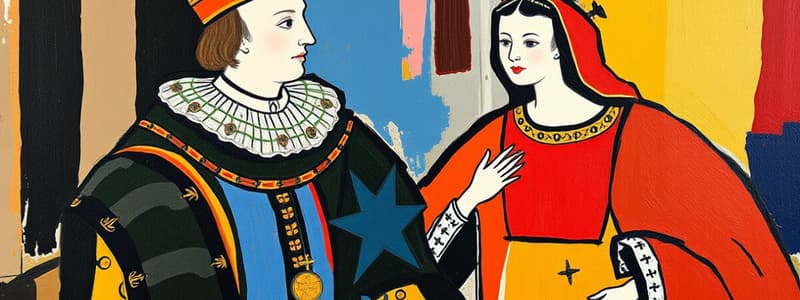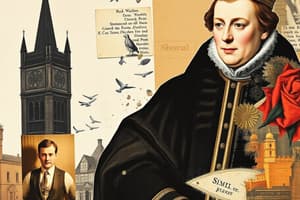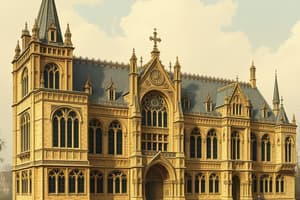Podcast
Questions and Answers
What was Somerset's approach to Lutheranism during Edward's reign?
What was Somerset's approach to Lutheranism during Edward's reign?
- He rejected all forms of Protestantism.
- He fully embraced evangelicalism.
- He had some sympathy with Lutheranism. (correct)
- He promoted Calvinism actively.
Edward was able to direct religious policy effectively from the start of his reign.
Edward was able to direct religious policy effectively from the start of his reign.
False (B)
Who publicly denounced images in February 1547?
Who publicly denounced images in February 1547?
Nicholas Ridley
Somerset's first significant actions towards religious reform took place in __________.
Somerset's first significant actions towards religious reform took place in __________.
Which of the following reformers was welcomed into Somerset's household?
Which of the following reformers was welcomed into Somerset's household?
Match the following individuals or groups with their characteristics related to Somerset's religious developments:
Match the following individuals or groups with their characteristics related to Somerset's religious developments:
The majority of lower clergy and the general population were in favor of Protestant reforms right away.
The majority of lower clergy and the general population were in favor of Protestant reforms right away.
What was one major risk Somerset faced by embracing Lutheranism?
What was one major risk Somerset faced by embracing Lutheranism?
What were many people essentially described as in relation to their religious practices?
What were many people essentially described as in relation to their religious practices?
People understood the reforms that were implemented by the authorities.
People understood the reforms that were implemented by the authorities.
What did congregations demonstrate in their response to the Marian Restoration?
What did congregations demonstrate in their response to the Marian Restoration?
Most people retained enthusiasm for Catholic practices until they were __________.
Most people retained enthusiasm for Catholic practices until they were __________.
Match the following concepts with their descriptions:
Match the following concepts with their descriptions:
What significant change was implemented in churches by the Royal Injunctions of November 1550?
What significant change was implemented in churches by the Royal Injunctions of November 1550?
The Second Book of Common Prayer was heavily influenced by Catholic theology.
The Second Book of Common Prayer was heavily influenced by Catholic theology.
Who was primarily responsible for issuing the Second Book of Common Prayer in 1552?
Who was primarily responsible for issuing the Second Book of Common Prayer in 1552?
The act of kneeling during the Communion service was clarified in the 'Black Rubric' as simply one of _____ rather than of worshipping an idol.
The act of kneeling during the Communion service was clarified in the 'Black Rubric' as simply one of _____ rather than of worshipping an idol.
Match the religious figures to their contributions or ideas:
Match the religious figures to their contributions or ideas:
What was the primary aim of the Treason Act introduced in January 1552?
What was the primary aim of the Treason Act introduced in January 1552?
Edward VI's religious reforms were uniformly accepted across England.
Edward VI's religious reforms were uniformly accepted across England.
What specific reform did Bishop Bonner's removal indicate in 1550?
What specific reform did Bishop Bonner's removal indicate in 1550?
The new version of the Eucharist ceremony was renamed the __________.
The new version of the Eucharist ceremony was renamed the __________.
How did the majority of parishes respond to the reforms by 1553?
How did the majority of parishes respond to the reforms by 1553?
Match the church concepts with their definitions:
Match the church concepts with their definitions:
By 1553, England had officially adopted numerous Catholic doctrines.
By 1553, England had officially adopted numerous Catholic doctrines.
What was the primary method for enforcing adherence to the Second Book of Common Prayer?
What was the primary method for enforcing adherence to the Second Book of Common Prayer?
The primary theological influence for Cranmer in developing the Second Book of Common Prayer was ______.
The primary theological influence for Cranmer in developing the Second Book of Common Prayer was ______.
Which statement best represents the religious climate during Somerset's regency?
Which statement best represents the religious climate during Somerset's regency?
Somerset's government strictly punished the laity for not attending church services.
Somerset's government strictly punished the laity for not attending church services.
What role did visitations play after the Act of Uniformity?
What role did visitations play after the Act of Uniformity?
Bishop Hooper found that ______ of his 311 priests could not recite the Ten Commandments in his diocese.
Bishop Hooper found that ______ of his 311 priests could not recite the Ten Commandments in his diocese.
What was one of the key outcomes of Warwick's purge of conservative voices?
What was one of the key outcomes of Warwick's purge of conservative voices?
The reforms under Somerset were characterized by a strong new statement of doctrine.
The reforms under Somerset were characterized by a strong new statement of doctrine.
What was the controversy surrounding the new Ordinal introduced in January 1550?
What was the controversy surrounding the new Ordinal introduced in January 1550?
Warwick's rise to power was marked by a shift towards ________ reform.
Warwick's rise to power was marked by a shift towards ________ reform.
Which individual challenged Archbishop Cranmer and Bishop Ridley regarding ordination procedures?
Which individual challenged Archbishop Cranmer and Bishop Ridley regarding ordination procedures?
The Book of Common Prayer denied the concepts of transubstantiation and purgatory.
The Book of Common Prayer denied the concepts of transubstantiation and purgatory.
What did William Paget observe about the state of religious reform in mid-1549?
What did William Paget observe about the state of religious reform in mid-1549?
Match the following individuals with their perspectives on religious reform:
Match the following individuals with their perspectives on religious reform:
Many thinkers exposed to radical reformist ideas of _____ and Zwingli returned to England.
Many thinkers exposed to radical reformist ideas of _____ and Zwingli returned to England.
What role did the nobility and gentry play in the reform process under Somerset?
What role did the nobility and gentry play in the reform process under Somerset?
What was one of the key changes made by the Royal Injunctions?
What was one of the key changes made by the Royal Injunctions?
The practice of iconoclasm refers to the removal of traditional folk practices in the Church.
The practice of iconoclasm refers to the removal of traditional folk practices in the Church.
What was the main purpose of the Book of Common Prayer?
What was the main purpose of the Book of Common Prayer?
The practice of removing church decorations is known as ___ .
The practice of removing church decorations is known as ___ .
Match the following religious practices or items with their descriptions:
Match the following religious practices or items with their descriptions:
Who was the primary author of the Book of Common Prayer?
Who was the primary author of the Book of Common Prayer?
During the reforms under Somerset, new radical religious texts were published due to the relaxation of censorship laws.
During the reforms under Somerset, new radical religious texts were published due to the relaxation of censorship laws.
What was significant about the Chantries Act passed by Parliament?
What was significant about the Chantries Act passed by Parliament?
The _____ made it clear that only authorized clergy were allowed to preach.
The _____ made it clear that only authorized clergy were allowed to preach.
Match the following reforms with their effects:
Match the following reforms with their effects:
What did the Royal Injunctions specifically ban?
What did the Royal Injunctions specifically ban?
Priests were permitted to marry under the new reforms.
Priests were permitted to marry under the new reforms.
How did Somerset respond to the radical reforms during his leadership?
How did Somerset respond to the radical reforms during his leadership?
The term 'faith alone' is associated with the idea of _____ .
The term 'faith alone' is associated with the idea of _____ .
Flashcards are hidden until you start studying
Study Notes
Religious Development Under Somerset
- Edward VI, influenced by evangelical beliefs, lacked the authority to direct ecclesiastical policy due to his young age.
- Somerset, showing sympathy for Lutheranism, welcomed reformers but did not aim for radical changes.
- Edward's regency faced the dual challenge of balancing reform with the risk of alienating Catholic allies like Francis I and Charles V.
- Evangelicals, returning from exile, raised tensions, particularly when Bishop Nicholas Ridley condemned images in early 1547, leading to some abandoning the Mass.
- Somerset adopted a cautious approach, issuing Royal Injunctions in July 1547 that reinforced and expanded upon previous injunctions, leading to iconoclasm.
- Key measures included forbidding church decorations, mandating the English Bible, and enforcing English preaching by priests.
- Enforcement of reforms was initiated through visitations despite opposition from conservative bishops like Gardiner.
- In November 1547, Parliament repealed the Act of Six Articles, signalling a legal shift away from Catholicism and allowing for the growth of radical ideas.
- The Chantries Act of 1547 dissolved chantries, raising funds for military campaigns, while indicating a push toward evangelical thought.
- By 1548, unrest grew as radical texts circulated, leading Somerset to reassert Catholic rites and restrict preaching to control the pace of reform.
- The Book of Common Prayer, issued in 1549, represented a significant liturgical change, but retained elements of Catholicism like vestments and holy days.
- Somerset's reforms appeared insufficient, splitting the public between reformers and Catholics, leading to mixed adherence to the new practices.
Religious Reform Under Northumberland
- Removal of Somerset in October 1549 resulted in increased division within England’s religious landscape.
- Northumberland allied closely with evangelicals, eliminating conservative voices from the council.
- His leadership marked a shift towards a stronger evangelical path, influenced by radical reformist ideas prevalent between 1547 and 1550.
- Initial reforms faced controversy, as seen in John Hooper's clash with Cranmer over ordination procedures and vestment requirements.
- Legislative changes in 1550 mandated plain wooden altars and surplices for priests, continuing the trend of iconoclasm established under Somerset.
- 1551 saw further consolidation of evangelical control, with conservative bishops removed and church valuables confiscated.
- The second Book of Common Prayer, introduced in January 1552, eliminated Catholic vestiges, affirming the commemoration of the Eucharist without transubstantiation.
- The Second Book, backed by strict laws, aimed to enforce conformity through harsh penalties for noncompliance.
- The 42 Articles were presented in 1552, reflecting strong evangelical doctrines, though they were never enacted due to Edward's death in 1553.
Religious Reform Under Edward – Assessment
- By 1553, England was officially Protestant with an evangelical majority among bishops and a Protestant king.
- Reforms signified the influence of continental reformers but faced internal resistance from the laity.
- Evangelicals like Bucer critiqued the pace of reform, suggesting that public adherence was superficial and old superstitions remained prevalent.
- Bishop Hooper noted the public's reluctance to fully embrace the new doctrines, highlighting simmering opposition to imposed changes.### Protestants and Catholicism in Early Modern England
- Protestant enthusiasm in London was low, with only 20% showing real commitment to the movement.
- Catholicism maintained strong popularity in northern regions like Lancashire, Staffordshire, and Worcestershire.
- Eamon Duffy, in ‘The Stripping of the Altars,’ highlights that many individuals pragmatically adapted to survive under oppressive changes by selling their Catholic heritage.
- Most people retained affection for Catholic rituals until these practices were outright banned by authorities.
Understanding of Reforms
- Many laypeople and some clergy lacked a clear understanding of the implemented reforms, indicating confusion and resistance.
- Pragmatic behavior was prevalent until the reforms were enforced, suggesting individuals may not have genuinely supported Protestantism.
Indicators of Popular Sentiment
- Wills from various regions show differing levels of enthusiasm for religious reforms.
- The rapid acceptance of the Marian Restoration by congregations signifies a lack of true allegiance to Protestant reforms, revealing underlying Catholic sentiments.
Studying That Suits You
Use AI to generate personalized quizzes and flashcards to suit your learning preferences.




